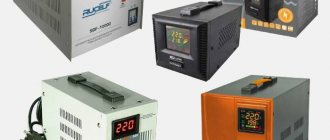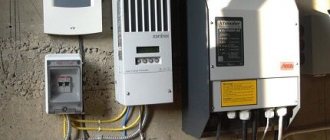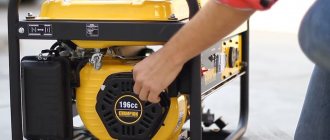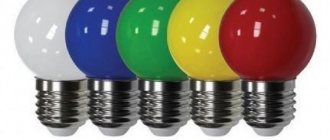Problems in electrical networks
Electricity is supplied to homes through the supplier's power lines and step-up transformers, traveling several hundred kilometers. The loads will be divided between the connected houses after installing the step-down unit. Installing an individual transformer is much more profitable, but it is also more expensive - the internal electrical network will receive a current reduced to 220 V.
The problem of regular voltage drops in the electrical network, during which devices cannot function normally, can be solved by installing a step-up transformer.
We assemble with our own hands
A do-it-yourself converter can be a solution to some problems. For example, if for garage work you need to connect equipment with a 220 V power supply, but the network has a voltage of only 36 V, then a self-assembled step-up transformer will solve this problem.
Interesting material for review: useful information about current transformers.
Types of converters 12 to 220 volts
Inverters are devices that allow you to convert direct current values, including 12 V, into alternating current with or without changing the voltage level. Current DC voltage converters currently produced can be represented by:
- voltage regulators;
- voltage level converters;
- linear stabilizers.
It will be interesting➡ How to check a varistor using a multimeter?
As a rule, such devices are generators of periodic voltage close to the shape of a sinusoid.
Converter circuit 12 to 220 volts.
Interesting material on the topic: how to assemble a Tesla coil yourself.
Classification and types
Transformers are divided into several types depending on their application and technical characteristics. The main classification parameters are:
- Number of windings.
- Number of phases.
- Cooling method.
- Accuracy class or possible errors.
- Type of allocation.
Transformers designed to regulate electric current are called current transformers. If the device regulates voltage, then it is called a voltage transformer.
The voltage varies depending on the number of transformer windings:
- The primary takes the voltage.
- The secondary transmits the changed voltage.
A transformer for a home is called a step-up transformer if it has more turns in the secondary winding than in the primary, otherwise it is a step-down transformer.
The cross-section of the winding wires affects the power of the transformer, the materials used to make the wires and the type of core affect the size and weight of the device. All devices according to the type of execution are divided into three-phase and single-phase.
The simplest transformer with minimal weight and compact dimensions is considered to be an autotransformer with one winding. Such models are budget options and are most often used in automatic devices and high-voltage electrical networks. Autotransformers do not have galvanic isolation, which is their disadvantage.
Power transformers are used to supply and receive electricity to and from power lines. Electrical appliances are equipped with network devices.
Design and principle of operation
A step-up voltage transformer includes several components that ensure the operation of the device. The structure is based on an iron core on which two coils are wound. The influence of alternating current voltage passes through the first coil, resulting in the formation of a magnetic field that implements the principle of electromagnetic induction. According to the formula dФ/dt, the strength of the magnetic field can be increased by increasing the current values to the required values.
Here we should not forget about the direct dependence of the magnetic field voltage indicators on a certain number of windings that are located in the iron core. Accordingly, the fewer turns, the less tension.
Therefore, when the magnetic flux passes through the line of windings of the second coil, voltage will arise there. These indicators will be calculated using the formula: NF/dt , where N is the number of turns of the coil itself. This is the so-called Faraday's Law , according to which the voltage will be the same frequency as on the first coil .
More details about the device in the video
Tips for choosing
Before purchasing a voltage stabilizer, you need to decide whether it is needed or not, but for preventive purposes it is still worth installing, since the voltage in electrical networks often varies.
When choosing a mini-transformer, the following characteristics are taken into account:
- Number of phases.
- Output power.
- Weight of the device.
- Transformer dimensions.
- Operational life.
- Operating voltage range.
- Speed of reaction to power surges.
The load of specific devices must be clarified. Single-phase transformers are purchased for low-power household appliances, three-phase stabilizers are purchased for a large number of devices that require load distribution.
One of the most popular and sought-after transformers is the Resanta ASN, a single-phase digital stabilizer with an affordable price of 2,600 rubles. This transformer is mounted on the wall.
A more expensive and reliable model is the Shtil stabilizer. Its approximate cost is 4,000 rubles. The Shtil stabilizer is optimally suited for protecting electronic equipment and household appliances at alternating voltage.
Voltage transformers
Voltage transformers are static electromagnetic devices that change alternating voltage. Such stabilizers are divided into several categories depending on their purpose:
- Power. They are used to increase and decrease voltage, which allows current to be transmitted over long distances and to consumer devices.
- Technological. High-power devices used for technological purposes - furnace, welding and others.
- Low-power. Installed on television and radio equipment, household appliances and various electronic circuits.
- Measuring. Used to expand the measurement boundaries of devices.
Voltage transformers can be used for both monitoring and measuring voltage and power. They can power alarm systems, electrical automation circuits and effectively protect power lines.
Using the example of a socket
So, generators at power plants produce electrical energy. It is transmitted through power lines to our homes, where we consume it. We are accustomed to the fact that the electricity we consume is based on a voltage of 230 volts and a current usually not exceeding 16 amperes per outlet (depending on the power consumption of the device that we plug into it). If we plug a heater into the outlet that causes a current of 16 amperes in the network, this will mean that we consume power from the network 230 V * 16 A = 3680 watts. Let's remember - we consume not voltage or current, but power. That is, not volts or amperes, but watts. Actually, the electricity meter counts them for us.
A current of 16 amperes, passing from the input into the house to the outlet through wires with a cross-section of, say, 2.5 mm², heats them. The greater the current or the smaller the cross-section of the wire, the greater the heating, because the current-carrying electrons have to squeeze through the atoms of the conductor and constantly collide with them, which causes them (the atoms) thermal vibrations (thermal vibrations of the crystal lattice in which these atoms are arranged). More current (i.e. more electrons) requires a larger cross-section of wire so that the collisions are distributed over a larger volume and do not cause overheating.
The wire (especially of small cross-section) itself is a resistance, and works like the same heater. That is, when the wire is heated, we lose some of the power on it that we would like to bring to the heater.
Step-up transformers
These are power devices installed in electrical circuits for household or industrial purposes and increasing voltage. Depending on the area of use and characteristics, transformers for the home are divided into several types that supply voltage:
- Autotransformer. Single-phase single-winding device.
- Current transformer. A stabilizer consisting of a core, several windings, optical sensors and resistors.
- Power devices. Current transfer between circuits is carried out using electromagnetic induction.
- Anti-resonance stabilizers. Closed single-phase or three-phase devices.
- Grounded transformers. Equipped with a special type of winding.
- Peak transformers. Separate alternating and direct currents.
- Transformers for the home. Designed to transfer electricity from a source to a consumer device and eliminate interference in the operation of household devices.
In three-phase networks of industrial areas, transformers are mainly used that convert voltage from 220 to 380 V. They allow the creation of additional power lines and symmetrically distribute loads across phases in the absence of a 380 V network.
Parameter calculations
On a simple transformer the primary winding has 440 turns for 220 volts. It turns out 1 volt for every two turns. Formula for counting turns by voltage:
It will be interesting➡ How to make a flashing LED?
N = 40-60 / S, where S is the cross-sectional area of the core in cm2. The constant 40-60 depends on the quality of the core metal. Let's make a calculation for installing the windings on the magnetic circuit. In our case, the transformer has a window 53 mm in height and 19 mm in width. The frame will be textolite. Two cheeks at the bottom and top 53 - 1.5 x 2 = 50 mm, frame 19 - 1.5 = 17.5 mm, window size 50 x 17.5 mm.
- The winding of a simple high voltage transformer is 2.18 x 450 = 981 turns.
- Low voltage for filament 2.18 x 5 = 11 turns.
- Low voltage filament 2.18 x 6.3 = 14 turns.
We calculate the required diameter of the wires. The power of the transformer core with your own hands is 170 watts in size. On the network winding the current is 170 / 220 = 0.78 amperes. Current density is 2 amperes per mm2, standard wire diameter according to the table is 0.72 mm. The factory winding is made of 0.5 wire, the factory saved money on this.
The assembled magnetic core, together with the components and connecting elements, forms the core of the transformer. The part on which the windings are wound is the rod. The area of the system intended to complete the circuit and not carrying any turns of the circuit is called the yoke. The arrangement of the rods in space serves to divide the system into the following types.
Types of arrangement of rods.
Number of turns of the primary winding
We take a wire of 0.35 mm, 50 / 0.39 x 0.9 = 115 turns per layer. Number of layers 981 / 115 = 8.5. It is not recommended to draw conclusions from the middle of the layer to ensure reliability. Let's calculate the height of the frame with windings.
Primary of eight layers with 0.74 mm wire, 0.1 mm insulation: 8 x (0.74 + 0.1) = 6.7 mm. It is better to shield the high-voltage winding from other windings to prevent high-frequency interference. In order to wind the transformer, we make a screen winding from one layer of 0.28 mm wire with two layers of insulation on each side: 0.1 x 2 + 0.28 = 0.1 x 2 = 0.32 mm.
The process of winding a transformer coil.
The primary winding will take up space: 0.1 x 2 + 6.7 + 0.32 = 7.22 mm. Step-up winding of 17 layers, thickness 0.39, insulation 0.1 mm: 17 x (0.39 + 0.1) = 6.8 mm. On top of the winding we make layers of insulation 0.1 mm. It turns out: 6.8 + 2 x 0.1 = 7 mm. Height of the windings together: 7.22 + 7 = 14.22 mm. 3 mm left for filament windings.
You can calculate the internal resistance of the windings. To do this, the length of the turn is calculated, the length of the wire in the winding is taken, the resistance is determined, knowing the resistivity from the table for copper.
When calculating the resistance of the primary winding section, a difference of about 6 ohms is obtained. This resistance will give a voltage drop of 0.84 volts at a nominal current of 140 milliamps. To compensate for this voltage drop, we add two turns. Now during loading the sections are equal in voltage.
Home Step Up Transformers
They are installed in situations where the voltage of the electrical network is less than the required 220 V. Such models have a constant transformation ratio: with a stable voltage of the electrical network, the final figure will be significantly higher than that required to power electrical appliances, which can cause their breakdown. Output voltage control is provided on some models in manual mode. Industrial transformers cannot be installed at home, as their operation can be dangerous due to the use of specialized cooling oils.
Step-down transformers
To connect devices for which the voltage of 220 V is too high, step-down transformers of 15 or 10 volts are installed. The advantages of such transformers for the home are the following characteristics:
- Protection against fire and electric shock, which is important when using such devices in rooms with high levels of humidity - bathrooms, bathhouses and others.
- Minimum electricity consumption - low-voltage lighting devices consume several times less energy, unlike standard ones.
- Increasing the service life of devices.
Chargers for various gadgets and household devices are equipped with integrated transformers, and therefore they do not require the installation of such stabilizers. Self-installation of transformers for the home is necessary when installing low-voltage lighting based on halogen and LED lamps.
Maintenance and repair
It is advisable for a person who does not know the operating principle of electrical devices not to carry out repair work on this equipment, due to the possibility of electric shock. When repairing and servicing transformer devices, the only thing that can be fixed without unacceptable consequences is rewinding the transformer.
Before starting any repair work, it is necessary to check the transformer:
- The first step is to assess the condition of the device through a visual inspection, since sometimes darkened and swollen areas directly indicate a malfunction of the transformer winding.
- Determine if the device is connected correctly. The electrical circuit generating the magnetic field must be connected to the primary winding of the device. But the second circuit, which consumes the energy of the transformer, must be included in the output voltage winding.
- Phase filtering of the output signal is determined for both diodes and capacitors on the secondary winding of the device.
- The next step is to prepare the device for control measurement of parameters, i.e. remove the protective panels and covers to gain free access to the circuit elements. Using the tester, you need to subsequently measure the voltage of the transformer.
- To carry out measurements, you need to supply power to the device circuit. The parameters of the primary winding are measured with a tester in AC mode. If the resulting value is less than 80% of the expected value, then the fault may be in the transformer itself or in the circuitry of the entire device.
- The output winding is checked using a tester. At the same time, we check the winding both for the possibility of short-circuited turns and for a break in the coil winding wire, according to the principle of measuring resistance (if the resistance is low, then there is a possibility of short-circuited turns, and in the case when the winding resistance is high, a break).
After rewinding the step-up voltage transformer, in the event of a winding malfunction, you need to assemble it in the reverse order, paying special attention to the tightest fit of the core plates.
Making or repairing a device yourself is a very complex and time-consuming process. To perform such work, you will need the necessary materials, as well as the ability to make some special calculations. In particular, you will need to accurately calculate the number of turns in the transformer winding, the diameter of the wires for the winding, as well as the cross-section and type of the device core.
Therefore, it is better to contact a qualified person who is familiar with the basic concepts and properties of electrical engineering and calculations using the necessary formulas to carry out these operations.










